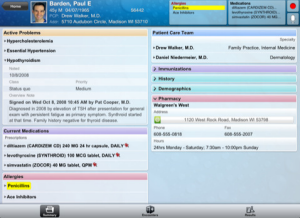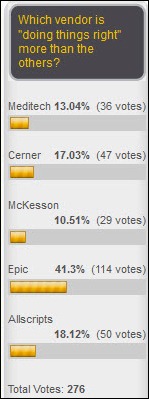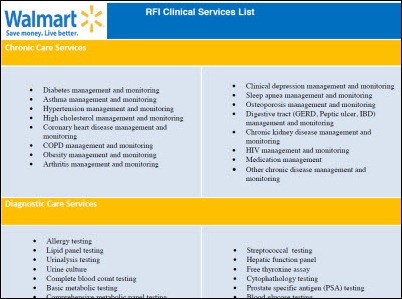I hear you, and I agree—HIMSS is definitely facing some big challenges right now. The leadership and governance issues you…
Monday Morning Update 11/14/11
From THB: “Re: Cheyenne Regional Medical Center. Going Epic.” The 218-bed hospital gets board approval to replace McKesson Horizon with Epic in a $19 million deal, saying it will cost about $5 million over five years to implement Epic. It says Meaningful Use money will offset that amount, and after that, Epic will actually be cheaper that McKesson. Epic doesn’t usually sell to hospitals that small, so either CRMC is affiliated with a larger Epic customer or Epic is started to push down into Meditech territory.
From WSDiner: “Re: HCA. At a Credit Suisse Healthcare conference investor dinner Thursday night, HCA’s management said they piloted Meditech 6.0 this year and will pilot Epic next year. They said that no other vendors (i.e., Cerner) were under consideration.” The reader provided a Credit Suisse contact to confirm, but he didn’t respond to my e-mail. This will be interesting if it’s true – my read has always been that HCA just wants to scare Meditech into better pricing by bringing in competitors, but Epic doesn’t walk away without a contract in most cases. HCA is Meditech’s largest customer, contributing 8% of the company’s revenue in 2010.

From Commodore: “Re: Cerner running poorly on the iPad. Do other inpatient vendors have native apps?” The only one I know of is Epic, which has Canto (above.) There may well be others. I tried using a couple of my hospital’s clinical apps the iPad using the Citrix portal and that’s definitely not something that’s workable for clinicians. The shrunken screen is impossible to comfortably read, you have to constantly zoom to hit tiny drop-downs with your finger, and the clicking doesn’t feel sure-footed at all. I think it’s safe to say that for most vendors, there’s not much to brag on if your iPad capability consists of running an emulated desktop screen. Only your marketing people will be impressed.
From The PACS Designer: “iPad viewer. The FDA has now approved an iPad viewer from Carestream called Vue Motion. The application permits the viewing of image files from many different PACS platforms, including cloud-based offerings, and can be integrated into EHR solutions to permit viewing of image files and patient records through a single sign-on.”
Here’s my summary of business lessons learned from the Steve Jobs biography.
My Time Capsule editorial from October 2006: Economics 101 and the Healthcare IT Market (that’s a pretty lofty premise to cover in 500 words). A Sam’s Club tiny paper cup-sized sample: “Hospitals can be convinced by questionable claims of product superiority or patient risk, and even more so by seeking vendors just as prestigious as they fancy themselves (no Walmart shopping for big academic medical centers, even though patients are the ones paying.)”
Note the reduced number of animated ads to your left thanks to those overachieving sponsors who have already traded out their animated ads in advance of the January 1 target date. I always feel bad when requiring changes like that, but it will benefit sponsors as well since readers will pay more attention to more subtle ads. I’ll digress by saying that while few things surprise me these days, one that does is the non-financial support I get from sponsors. Not all of them, since a few are purely ad placements without much personal connection, but the majority have executives and regular employees who keep in touch, send me music recommendations, e-mail me a well-timed attaboy right when I’m feeling overwhelmed or under-accomplished, or send off-the-record snarky comments about one thing or another. HIStalk is an after-work hobby for me rather than business and I like that the connections aren’t always business related.
Venture capital superstar and billionaire Peter Thiel, speaking at Practice Fusion’s conference (he’s an investor), says highly paid salespeople can land big businesses as customers and relentless marketing can get consumer sales, but companies that can sell to small businesses (like most medical practices) are rare since those small businesess are reluctant to change. He gave as examples QuickBooks and PayPal (implying Practice Fusion as well, naturally.) Also at the conference: Practice Fusion rolls out its iPad app, although I’m not clear if that’s a new native app or just the LogMeIn remote control version that was announced at HIMSS.
Doctors and hospitals in Boulder, Colorado are questioning whether joining Colorado’s statewide RHIO (CORHIO) is worth the subsidized cost. Small practices say the upfront training costs and $85 per doctor monthly fee are steep, and doctors at Boulder Medical Center says there’s not much value to them since they’re already connected via their NextGen systems. CORHIO’s five-year business plan called for taking in $26 million in federal grants and $19 million in subscriber fees.
Polls that list companies always bring out ballot box stuffers, but they’re fun nonetheless. Epic wins this one handily, with a fairly even spread among the losers. New poll to your right: how will ONC respond to the IOM’s report that criticized patient safety efforts related to electronic medical records?
We already know what HIMSS thinks of the IOM recommendations since Steve Lieber quickly released a statement. He zoomed right past all the patient safety concerns, preferring to focus on one sentence that says paper records are also risky, thereby summarizing the entire work as “a strong endorsement for the path healthcare is on.” Well, OK. He also is somewhat dismissive in saying IOM looked at only at the patient safety aspect of HIT and it’s already fussed about that before (which is exactly what you’d want IOM doing given that there are plenty of loud voices, especially that of HIMSS, extolling the virtues of technology for purely commercial reasons and ignoring IOM’s previous recommendations). A critic might say, “Who’s this association executive with no credentials in medicine, research, or technology speaking on behalf of his unpolled membership to critique the work of a large group of unbiased and extremely well-credentialed IOM medical experts whose thoughtful opinions were commissioned by ONC?” but to question the authority (audacity) of HIMSS to weigh in on complex national matters is just not done. If you say anything even slightly negative about commercially sold healthcare IT, HIMSS is going to hit the PR airwaves, often cherry-picking a few HIMSS-friendly members to chime in for credibility support. Choose your side: an unbiased group of scientists vs. an exhibit hall-funded trade group. I like some (maybe even most) of what HIMSS does, but its predictable knee-jerk defense of the industry and federal grants just annoys the heck out of me as a dues-paying member, especially given that so many of us members pride ourselves in spotting and debunking shoddy research methods, investigator bias, and inconclusive evidence, all in the interest of improving patient outcomes and reducing healthcare costs just like IOM is trying to do.
Here’s Vince’s latest HIS-tory, highlighting Healthcare Information Systems. I’m cringing a little because he attacks someone at the end, to be named in the next installment. I don’t know who it is, but I’m hoping that person is (a) not a reader; (b) dead; or (c) one of Vince’s pals he’s just joking around with.
Thanks to the following sponsors (new and renewing) that supported HIStalk, HIStalk Practice, and HIStalk Mobile in April. Click a logo for more information.
Epic hosted a college team programming competition in its offices this past Saturday. You wonder how many of the geeky combatants left with job offers, and also how the reporter kept a straight face in writing up details: “Winners and awards will be announced after the 4:30 p.m. conclusion of the competition, which will be held in the Nebula room in the Heaven building. Parking is available in the Yoda underground garage.”
Jackson Memorial Hospital takes part in a quickly assembled telemedicine project that will connect Miami specialists with hospitals in Iraq, part of a $1 billion contractor’s project as the State Department takes over field hospitals and medical care when US troops pull out December 31.
Weird News Andy wonders how many EMRs have edits that would prevent documenting this. In Mexico, a 10-year-old girl gives birth. You have to either admire or detest the creativity of the UK-based newspaper’s accompanying photo of a girl packing a toddler along in some kind of serape, clearly desperate for a visual, yet struggling with the lack of an Enquirer-like picture of a 10-year-old: the photo has nothing to do with the actual story and was “posed by models.” Its readers are apparently so stupid that reading text without even an irrelevant picture is unthinkable.
WNA also notes that health conditions are leaning toward the Third World in the Occupy Wall Street encampment. The unfocused unemployed there are coming down with a variety of respiratory infections as they sleep among their trash, pee in bottles without washing their hands, pass cigarettes and alcohol mouth to mouth, and refuse free flu shots because they’ve concluded that vaccines are a government conspiracy. They have a volunteer-staffed medical tent, but it only stocks herbal remedies.
ONC’s blog (which is actually written by its contracted PR company – it’s not like Farzad’s going to bare his innermost thoughts or music recommendations there) highlights the VA’s Blue Button initiative in honor of Veterans Day.
As Dr. Jayne mentioned, Walmart is denying that it plans to develop some kind of national primary care program, but they might want to check with their RFI people they’re clearly looking for partners to “rapidly create a comprehensive healthcare solution to deliver low-cost, high-quality primary healthcare services nationally.” The RFI lists specifically that partners should be able to offer chronic care services (diabetes, hypertension, etc.), lab tests, vaccinations, physical exams, health screenings, and durable medical equipment support. They say they will consider vendors who offer only “enabling technologies” as well, and the RFI requires prospective vendors to describe their proposed information system and “data sharing model.”
Ed Marx updated his most recent post to respond to reader comments. He’s always gracious, even to his anonymous attackers. And here’s the secret I shared with Ed: I don’t usually delete negative comments because I’d rather let readers provide the majority opinion via their own responses.
Speaking of Ed’s pieces, a few folks howl if I dare run anything that’s not directly related to their jobs, but many (most, maybe, especially at the senior levels) enjoy a mental break with personal stories about patients, working in HIT, or life’s lessons learned. Yours are welcome.
An Investor’s Business Daily article notes that its medical software sector dropped from #2 a month ago to #67, mostly due to the huge drop in CPSI’s share price after it missed expectations. The article says Cerner beat estimates but profit margins slipped in the most recent quarter, while Quality Systems shot itself in the foot in its earnings conference call by implying (but later clarifying) that most of its new sales were coming from replacements, suggesting that the market was past its peak. Athenahealth is mentioned for beating expectations but not by enough (double expectations?) and took a 7% share price drop as a result. On the positive side, shares in MedAssets jumped 14% and later 17% after beating estimates and Allscripts share price took a slight turn north after reporting results. Above is a one-year price chart of the shares of all those companies: Allscripts (blue), Cerner (red), Quality Systems (dark green), athenahealth (yellow), MedAssets (brown), and CPSI (light green). Leading the pack are Cerner and athenahealth. Looking at just the past three months, the clear winner is Allscripts, with MedAssets and Cerner basically tied for #2 but pretty far off the pace. Looking back five years, your best return would have been Cerner and Quality Systems. Always amusing is that ever-vigilant stock analysts flip-flop their recommendations a day or two after unusually good or bad news is announced, providing no benefit whatsoever for the clients paying them for non-retrospective advice.
I’m beginning to be annoyed by research companies selling expensive reports under the headline, “XX Market to Reach $X.XX Billion by XX.” One of these days I’m going to check the accuracy of their past predictions, which I suspect is minimal. Inga loves to run those press releases like they’re real news, along with the splashy results of questionably conducted surveys that are favorable to the companies paying to have them done. She’s usually good natured about my edict that she’s allowed only one survey mention per post.
Inga notes that Sage’s new name, Vitera, is also a band’s name. She and I don’t usually like the same music, but they’re good for an unsigned band, a Latin-style pop with a harder guitar edge, like a Spanglish Guns N’ Roses. Check out this live video and the flying V fiddle, which sounds to me like prog rock meets Texas swing.
A Jacksonville, FL woman starts a booming business that provides scribes to do patient care documentation for ED physicians. The scribes, often pre-med or nursing students, are contractors billed out at $20-25 an hour, a bargain according to the company’s medical director. “For every hour we spend, we get about 15 minutes at the bedside of patients and 45 minutes of every hour documenting everything … part of it’s insurance. Part of it’s medical-legal. Part of it is a federal mandate to have everything documented electronically.”
Startup accelerator Rock Health signs on UnitedHealth Group as a sponsor. It joins Microsoft, Nike, Qualcomm, and Quest.
Outsourcer and iSoft acquirer CSC reports Q2 numbers: revenue up 1%, EPS –$18.56 vs. $1.19, cutting guidance. The ugliness was caused by a massive $2.69 billion write-down of goodwill and a settlement of a contract dispute with the US government. Shares predictably tanked.
Two nurses file a class action lawsuit against Aurora Medical Center (CO) after being written up for trying to clock in before putting on their hospital-provided scrubs. They say they should be paid for the time it takes to go to the scrubs room, find some that fit, put them on, then go clock in.
History Mingles with Innovation in Atlanta
By Erin Sweeney, Director of Marketing
The Friedman Marketing Group
The “who’s who” on the Atlanta healthcare scene met at the historic Fox Theatre this week to discuss innovation and opportunity—along with military weaponry. The HealthIT Leadership Summit, founded by the Technology Association of Georgia, Metro Atlanta Chamber, and Georgia Department of Economic Development drew nearly 200 attendees and such notables as Drs. Robert Kolodner, Mark Dente from GE, and Kenneth Wilson, a U.S. Army Major who served three tours in the Middle East.
Key takeaways from the eyes of this healthcare marketing guru include:
- There is a whole new generation of healthcare IT experts ready to lead the charge.
- Analytics are a key capability for all healthcare IT systems.
- There are some really cool virtual reality glasses being tested in Afghanistan to help military medics and other first responders save lives—may come stateside soon.
- Vendors that enable ACOs through harmonization of multiple systems will be winners.
- Vendors that are behind can easily get ahead using new technology.
- Cloud computing is here to stay, on-premise is antiquated.
- Patients will spur providers to innovate.
- Boards will be more involved in quality improvement.
- Interoperability must happen between states.
- Average venture capitalist investment in healthcare IT is $3 – $5M.
- VCs are more interested in companies where technology is driving a service; and the two are not treated separately.
Amidst all the innovation, attendees did hear one reality check offered up by a panelist and based on research from Cigna Health: the average patient has 200 documents located in 19 different places.
And finally, Justin Barnes from Greenway Medical painted a gloomy picture for physician reimbursement and suggested groups ask themselves, “Do we interoperate or join an ACO?” Another panelist encouraged groups to look around and decide who they’ll affiliate with instead of waiting until the best dance partners are taken.
Overall, the Summit was interesting and a bit eye-opening. The TAG speakers and panelists added some fun and humor to the discussions. Dr. Dente pointed out that women are caregivers for not only their own elderly parents, but also their in-laws. Doctors’ appointments, prescriptions, transportation to and from check-ups — the women do it all. Looks like the upcoming holiday gatherings will be a walk in the park compared to what’s in store for this gal.













Re: Cerner running poorly on the iPad: PatientKeeper has always offered physician workflow applications via native apps. Better still, PatientKeeper offers native apps that aggregate and unify patient data from any EMR and clinical system, not just a single EMR that may or may not offer mobile access to a single system.
With all the noise about CPOE, devices, safety, Suzy, Prabda, etc. –
We should allow organizations to opt out of Meaningful Use without any penalty or stimulus to pursue use of HIT at their own pace and to further their own safety goals and care programs.
Let people do it at a pace they feel they can do safely. What we’ll see is that organizations who implement carefully have a significant safety improvement, but those who do a sloppy, rushed or poorly trained implementation run the risk of negatively impacting safety.
Congress passed a Stimulus plan, not a Regulate HIT and EHR Users Like Crazy plan.
ONC has significantly overstepped the intentions of Congress and it needs to be reigned in. This is government going overboard.
Computerization in Medicine has made its presence since 1960s(LINC by Medline, MUMPS ,introduction of AI by Shortliffe, etc ) Several historical evidences ( IOM reports on Medical Errors , Reports from the President’s Information Technology Advisory Council (PITAC) 2001, and several others were issued from the Institute of Medicine) These reports first time proved to be an attention grabber blaming the health care system for failing to use information technology effectively and to establish a regular monitoring system to track the quality of care. It took several decades to prove the presence of Health IT in the healthcare community. The AMA and several other physician organizations voiced their support for the IOM’s goals and the spirit of innovative technologies called for in the report. Several initiative actions were felt to achieve those goals, including evidence-based clinical guidelines, standardized performance measures and promoting systemic solutions for patient safety. Despite its felt usefullness its taking decades to adopt it . If the system is flawed and needs to be fixed immediately , a slow and delayed process will create more impediments towards its corrective action . Its like a an early diagnosed Cancer- the chances of survival are best if detected and treated earlier. So why to waste time on just arguing and waiting.
Any chance you have seen and can post the Cigna study? I have looked but can’t find in via google or Cigna’s website
Frankly, good for those nurses suing Aurora (CO). Putting on scrubs is a job requirement and is done on-site? Definitely paid time. It would be one thing if they were asking to be paid for time spend dressing at home, but that isn’t the case – they are putting on mandatory job-related equipment, and Aurora is shortchanging them. What’s next, we won’t pay workers during bathroom breaks?
If you listen to Steve Lieber of HIMSS your taking advice from someone who has no medical or technical experience but lots of experience as a D.C. Lobbyist. HIMSS actively lobbies but flies under the radar on lobbyist registration with careful load balancing on time spent in the “lobbying activities”. Lieber is a good schmoozer and knows how to get close to the right people at the right time but watch out for the cash flows- US Govt. money is going to disappear down his 501 C black hole.HIMSS only puppets an illusion of concern regarding patient safety– Congress knows it and so does the FDA and the IOM.
Smita, HIT is a cancer that needs chemotherapy to slow its growth. Some of its good cells should be grown in tissue culture and infused into certain comppnents of the health care system.
Simple and safe, the HIMSS and HIT sellers have had freedom to make their devices as safe as they wanted for the past 20 years. They failed, according to the IOM White Paper.
Digital errors have affected me and my family. Has the new mantra become to err is digital?
LIEber and HIM$$ does not think so, but what would you expect from the trade and lobby group that educated Congress to vote boatloads of cash to enrich members of HIM$$?
Many Thanks to the IOM for at least taking the road toward safety and I want to thank the Academy too. About the issue Mr. Lieber raises: “The paper-based health system kills”; the medical record consists of 4 parts dating back to the 5th Century BC . Hippocrates is generally known as its creator developing the 4 parts as
1.Case Records collection of the 19th century, resembling “diaries or research notebooks”;
2. Bedside chart containing individual patients’ vital signs and observations;
3. Physician order, used for workplace communication; and
4. Financial ledger, or record of physician charges and transactions.
Lieber’s one liner when considered would only have physicians spanning 2500 years racing toward him with scalpels and outrage. Lieber can’t even add in binary much less make the argument that paper or papyrus kills (1+1= 0010). What we see is a cheap form of ventriloquism emerging as print media from one of his hired hands working on the HIMSS ranch inside the Beltway. Are we now to play paper , computer, scissors? I’d say paper and its overall usefulness will outlive the EHR’s of today which really are after all, just the offspring of Xerox copy machines with “Form-Filler” technology , encryption and packet switching technology tied together. Big Deal- this idea was invented in 1959 by people at PARC and its still not as good as paper or sliced bread.
I hope that Vince is just kidding. Your blog is no place for a personal vendetta, which is what it looks like.
Perhaps this is just a great set-up (I hope)